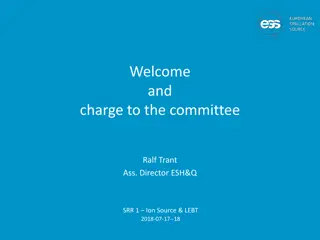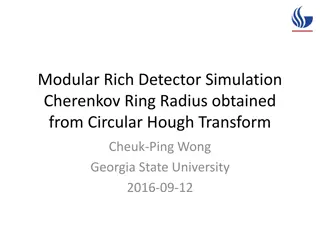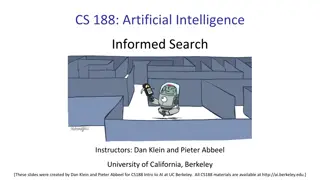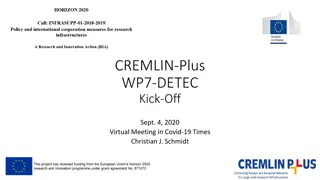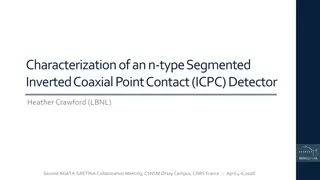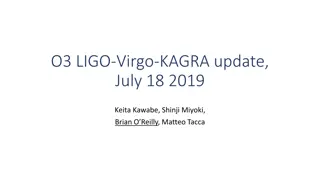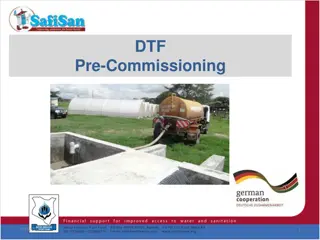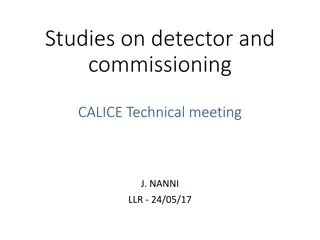Commissioning and SUSY Search with Same Sign Leptons in Pixel Detector Post-IBL Insertion
The ATLAS Pixel Detector, augmented by the Insertable B-Layer (IBL), underwent commissioning to enhance tracking precision and sensitivity to b-jets. Motivations for IBL insertion included preservation of detector performance, robustness against radiation damage, and improved b-tagging capabilities. An analysis was conducted on Pixel cluster properties, including Cluster Size, Cluster Charge, Cluster Time, Lorentz Angle, and Threshold over Threshold (ToT), using data from cosmic data campaigns.
Download Presentation

Please find below an Image/Link to download the presentation.
The content on the website is provided AS IS for your information and personal use only. It may not be sold, licensed, or shared on other websites without obtaining consent from the author.If you encounter any issues during the download, it is possible that the publisher has removed the file from their server.
You are allowed to download the files provided on this website for personal or commercial use, subject to the condition that they are used lawfully. All files are the property of their respective owners.
The content on the website is provided AS IS for your information and personal use only. It may not be sold, licensed, or shared on other websites without obtaining consent from the author.
E N D
Presentation Transcript
Commissioning of the Pixel Detector after the IBL Insertion, and SUSY search using the Two Same Sign Leptons Channel Mahmoud I. Alstaty Supervisors: Far s Djama and Pascal Pralavorio CPPM PhD Days November, 25, 2015 1
The Pixel Detector and the Insertable B-Layer Innermost tracking detector of ATLAS. A semiconductor detector made of hybrid silicon modules. Composed of two parts: the 3-L ATLAS Pixel Detector (3 barrel layers and 2 x 3 endcap disks), and a recently added innermost layer: Insertable B-Layer (IBL). IBL insertion required a reduction of the diameter of the beam pipe (radius = 29 23.5 mm). The IBL was installed in the center of ATLAS in May 2014. 2
Motivations for the IBL Insertion Preservation of high performance of the Pixel detector despite the radiation damage, especially relevant in the B-Layer, which was the innermost layer in Run 1. Enhancement of tracking robustness and precision of the Inner Detector. Improvement of vertexing and b-tagging performance, even in the foreseen conditions of higher radiation doses, pile-up and luminosity. Requirement to get higher sensitivity for signals in physics channels involving b-jets. 3
The IBL Facts 14 staves, full azimuthal hermeticity. Two sensor technologies: Planar sensors (double chip sensors, 12 per stave), based on the Run 1 Pixel detector design, with slim edge and thickness of 200 m (produced by CiS). 3D sensors (single chip sensors, 8 per stave), used for the first time in a particle detector with thickness of 230 m (produced by CNM and FBK). 32 FE-I4 readout chips per stave: designed to cope with high radiation and high hit multiplicity. 26880 pixels/FE-I4 . Pixel Size: 250x50 m2. 4
Cosmic Data Campaigns Cosmic Data was analysed during several months on different detector conditions to test the detector response, and to help in the detector tuning and calibration. 5
Elements of the Analysis Studying the different Pixel cluster properties, both in Pixel and IBL, such as: Pixel Cluster Size: in eta and phi. Pixel Cluster Charge: the charge collected in the silicon sensors after the passage of a charged particle. Pixel Cluster Time measured in units of Bunch Crossing (BC), and it is defined as the time slot during which a pixel charge is higher than a given threshold. Lorentz Angle: more details in next slides. over Threshold (ToT): 6
Lorentz Angle Lorentz Angle ??: the angle by which the liberated electrons inside the silicon sensors are deflected by the magnetic field from their normal paths. tan ??= ????? The electron mobility is temperature dependent. Consequently, ??is found to be inversely proportional to temperature. Measuring ??is needed because it should be taken into account when determining the real particle track position depending on the pixel hits whose positions are affected by it. 7
Lorentz Angle Data/MC (M9) Comparisons between cosmic data and Monte Carlo (MC) is needed to tune MC and make it more realistic. The Lorentz angle MC in Run 1 was scaled by 0.9 to match data. We confirmed that no additional scaling is needed. The discrepancy between data and MC at large incidence angle is a well known observation from Run 1, and it shows that the cluster splitting due to threshold effect is stronger in data than in MC. 10
IBL Planar Lorentz Angle Vs Temp (M9) Astonishing agreement: The linear fit gives a slope of -0.74 0.21 mrad/ C for the IBL Planar in 2015. The linear fit gave a slope of -0.74 0.06 mrad/ C for the Pixel layers in 2008-2009. 11
Ongoing study: The B Layer Evolution in Run 1 Some runs from 2012 (runs were chosen all along the 2012 data taking) were used. More runs from 2011 are to be added. The depletion voltage increases with radiations. Lorentz angle increases with the total depletion voltage. To study can the irradiation effect in the innermost layer at that time, and hence be able to test some irradiation models. We plan to write a note, which might become a paper, about this study. 12
Ongoing study: SUSY Analysis Just started since two weeks in the SUSY Analysis (2lepton same- sign channel). The two main subjects of my work will be : Fake lepton estimation: one of the main background of this analysis. Signal region optimization for 10fb-1. My work is to be included in a CONF note with 10fb-1 of 13 TeV data at ICHEP 2016 conference. 13
Summary Finished most of my detector oriented research (my qualification task). Already started writing this part of my thesis. Just started my SUSY analysis part. Goal is to produce some interesting SUSY results before next Summer, in order to show them in conferences. 14






